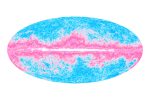
© 2021 Jonathan Feldschuh
Recent advances in computer-imaging technology have allowed scientists to picture the inconceivable by capturing background radiation emanating from the Big Bang. The result is a beautiful digital rendering that still gives the novice very little sense of what the universe actually looks like. Jonathan Feldschuh has made the wise decision to turn these data accumulations into something more tangible, a painting such as Early Universe North Galactic Hemisphere. Not that anyone still believes in painting’s truth-telling capacity, but acrylic on canvas offers a degree of materiality that is welcome when dealing with mind-bending abstractions.
While the attempt to cram the entire universe into a canvas is clearly quixotic, it is hardly unusual in the history of modernism to think in terms of universals. The early moves toward total abstraction in the work of artists like Malevich, Mondrian, and Kandinsky were accompanied by utopian claims about greater communicability and higher states of consciousness. This generation of artists was also impressed by recent developments in the laboratory, for instance the experiments by particle physicists that revealed the properties of atoms. Being personally educated in physics, Feldschuh is hardly new to these discussions, but a shared sense of awe before the miracle of science is present in his work.
Although Feldschuh’s latest series, Macrocosm, concretizes maddeningly complex information, it yet again reveals art’s fictional status. As Picasso famously pointed out in 1923, “Art is a lie that makes us realize the truth, at least the truth that is given us to understand.” The second half of this line is often left out when historians quote Picasso, but it is this part that has the greatest relevance for Feldschuh’s new work. For he focuses on the most up-to-date knowledge that is available from astrophysics. He then aligns the relatively antiquated technique of painting with the outer limits of scientific research to produce enticing images that might be taken for straightforward abstractions. One is thus compelled to question whether art is any more suited to representing the unrepresentable than traditional fact-gathering documents like charts, graphs, or numerical tables.
If we find ourselves overwhelmed by the sheer physical scope of most works in the Macrocosm series, Feldschuh’s Hurricane brings us to a comparatively stable place. Making use of a photograph taken by an orbiting astronaut of the earth’s atmosphere during a massive storm, he concentrates on swirling cloud formations as they rotate above the deep blue of the ocean. A pleasurably mild vertigo is induced akin to that presented in Charles and Ray Eames’s 1977 film Powers of 10, in which successive images, beginning in outer space, rapidly bring us into the microcosmic world of the human cell structure, a locale that Feldschuh has also consistently explored. Yet he adds an element of distortion via thickly applied paint that conditions the experience of these abrupt shifts in scale. The multiple layers of acrylic are built up in such a way that standing close to the canvas renders the scene almost unrecognizable. Though the earth view rescues us from purely abstract visual statistics, Feldschuh seems to suggest that the closer you look, the less you know.

© 2021 Jonathan Feldschuh